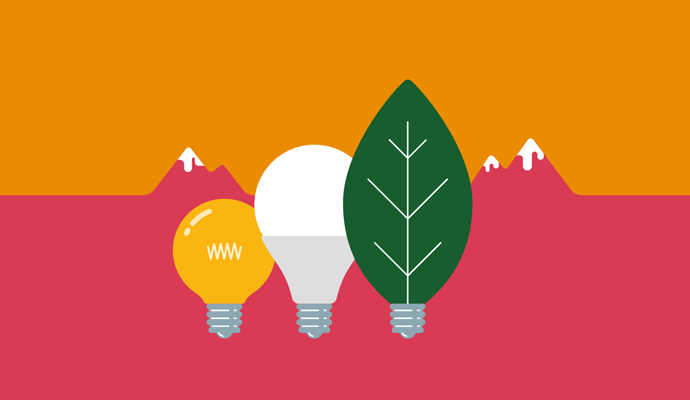Energy Deregulation and the Web—Still Waiting for a Spark
The Web can deliver the fruits of energy deregulation once consumers and suppliers adjust to new business rules and new technology.
The last half of 2000 will be remembered for power outages and unprecedented price spikes in electricity bills. In particular, Californians are living under the threat of rolling blackouts. Nationwide, businesses are struggling to manage the risks created by the deregulation and restructuring of America's $220 billion electricity market.
It wasn't supposed to be this way. The piece-by-piece deregulation of recent years was meant to deliver lower prices through the discipline of the Web-enabled marketplace.
In reality, however, the Internet has yet to offer businesses a more cost-efficient channel through which to purchase electricity. Those are key findings from "Electricity Liberalization, the Internet, and the U.S. Business Customer," a recent survey of more than 500 commercial and industrial (C&I) power customers conducted by Booz-Allen & Hamilton. The question is: What has to happen for the Internet to spark change in this market?
A Tough Transition
Overall, most business customers are sticking with their local utilities rather than risking alternative suppliers. So far, only about 20 percent of business customers have switched electricity providers, due to the inability of many suppliers to offer price savings. Nonetheless, most of those that have switched saved 10 to 20 percent on their electric bills. On the other hand, about 10 percent either saved nothing or paid higher prices.
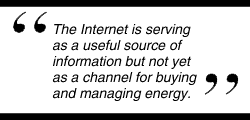
Furthermore, the Internet has not met customer expectations as a catalyst to reduce electricity costs. It is serving as a useful source of information but not yet as a channel for buying or managing energy.
A patchwork approach to deregulation lies behind the difficult transition. Starting in the late 1970s, rising electricity rates led businesses and policymakers to question whether regulated local utility monopolies still made sense. Several high-rate states began experimenting with rules that would allow customers to choose among alternative power retailers. In effect, the electricity industry followed the telecommunications model: The industry was "unbundled" into competitive (generation and retailing) and regulated (distribution) segments.
Over the last three years wholesale markets and new systems for operating power grids were launched as part of the transition to competition. Uncertainty around liberalization, coupled with environmental restrictions and local resistance to plant construction, deterred investment in increasing power generation in some states, most notably California.
At the same time, a significant number of older, less-efficient plants were retired. Economic growth and increased use of electronics boosted demand far beyond forecasts, and well beyond growth in supply. Thus, prices began to fluctuate at the same time supply and demand moved in clashing directions. These conditions led to outages and unusually high wholesale prices.
Enter the Internet
Deregulation has taken place during the rise of the Internet, which came along at the right time to give new suppliers a place to market their services and give customers a way to learn about alternatives. What is the role of the Internet, now and in the future? The Booz-Allen survey debunks several myths about the Web that arose in the first blush of excitement about deregulation.
Myth: Internet-based B2B energy procurement will dominate after deregulation.
The Internet would quickly deliver the fruits of deregulation. Consumer and business buyers were going to switch easily among competing customer-focused online energy retailers such as Utility.com, Essential.com, and The New Power Company.
Reality: B2B e-commerce has yet to have much impact in the C&I retail energy market.
Although the Web is beginning to gain acceptance as a useful tool among industrial energy purchasers, so far it plays a limited role. (See Exhibit 1.) Two-thirds of the businesses surveyed said they use the Internet regularly to conduct business, and 40 percent said they visit energy-related sites, but nearly all use the Internet simply to gather information on energy prices, competitive offers, and technical matters. Just two percent have actually ordered energy via the Internet.
Exhibit 1: Corporate Uses of the Internet for Electricity Management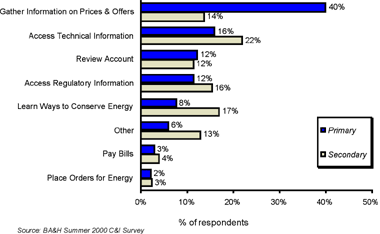
Myth: The Internet will lower B2B customer acquisition costs.
Many studies predicted that the Web would lower customer acquisition costs to unheard-of levels and rapidly increase the number of customers switching to new suppliers.
Reality: The Web is not yet a channel for C&I customer acquisition.
Several important factors limit the use of the Internet to acquire C&I customers, most notably customer resistance. Given that electricity is critical to their operations, purchasers want to know that a supplier is reliable and responsible. It takes an experienced supplier sales team to win a new customer's confidence.
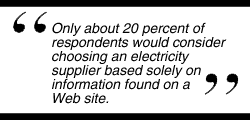
Only about 20 percent of respondents would consider choosing an electricity supplier based only on information found on a Web site. (See Exhibit 2.) This reluctance was most pronounced among large energy-intensive and high-tech companies. The survey found that most C&I customers thoroughly investigate different options, or use an energy consultant, to select a supplier. Purchasers who did not take this deliberative approach were far more likely to experience cost increases after switching suppliers.
Exhibit 2: Company Willingness to Purchase Power Via the Internet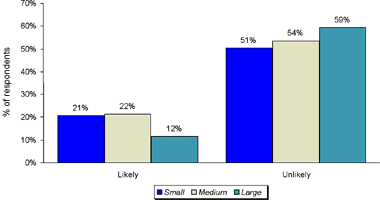
Another roadblock is the scarcity of clear, comparable prices—a huge frustration for the many companies that are desperate to find price details online. (See Exhibit 3.) Internet-based energy markets do not provide enough information for buyers to make a rational decision about their options. In mature markets such as equities, buyers can turn to online exchanges and find a price that reflects the "center of gravity." In the case of online electricity, however, buyers find a range of unconnected prices that give no reliable indication of what they would actually pay.
Exhibit 3: Company Demand for Online Price Information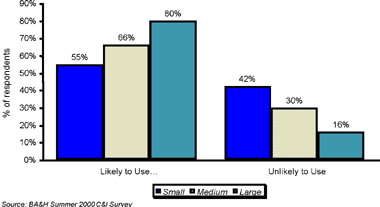
Myth: The Internet enables customized segment-of-one services and products.
Internet retailing was supposed to allow suppliers to customize products to each individual account, enabling new e-markets to offer detailed information and rich interactions to enhance the buyer's decision-making power.
Reality: The Internet doesn't yet offer the depth of information or degree of real-time interactivity required to provide customized energy management, despite C&I customer interest.
Our survey found a pent-up desire among many companies to use the Internet to identify and implement ways to reduce energy bills. (See Exhibit 4.) A growing number of software packages and consulting services, many delivered over the Web, provide basic analysis of a business's energy usage and expense, and identify potential savings. However, the Internet will become a far more compelling energy management tool for customers once suppliers can offer consolidated online billing, real-time usage analysis, and up-to-the-minute prices.
Exhibit 4: Company Interest in Internet-Based Analysis of Energy Use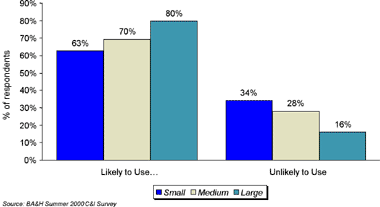
Many of these tools are available today—California software developer Silicon Energy offers electricity usage management systems, for instance—but obstacles remain. Most customers lack adequate Internet bandwidth to transmit and receive the streams of data required by such systems. A more serious problem is that energy suppliers have yet to figure out how to create a total package of data, analysis, and contracts. Customers will respond more favorably to a complete solution to their energy needs rather than to bits and pieces they have to assemble themselves. The innovative supplier who can devise and market this comprehensive package will create a real competitive advantage.
Learning to Play by New Rules
For the moment, the Internet is no godsend for either power retailers or their customers. But that doesn't mean it won't be—and soon.
The last 20 years have proved that liberalizing markets is never easy, and no one expected the electricity market to be an exception. Yet, on balance, the record so far indicates that C&I customers will gain greater benefits as power supplies increase and as retailers harness the power of the Internet. While adapting to new technologies and new market conditions involves additional costs for C&I customers, we expect them to keep finding savings, too. Perhaps the best news is that those companies—both suppliers and their customers—that learn how to play the game first can gain an enduring competitive edge.
| Authors
Kyle Datta, datta_kyle@bah.com is a San Francisco-based partner who leads the US utilities group within Booz-Allen & Hamilton's Energy Practice. Mr. Datta is a strategist focused on corporate and business unit strategies for utilities facing deregulation and privatization. Dan Gabaldon, gabaldon_dan@bah.com |


